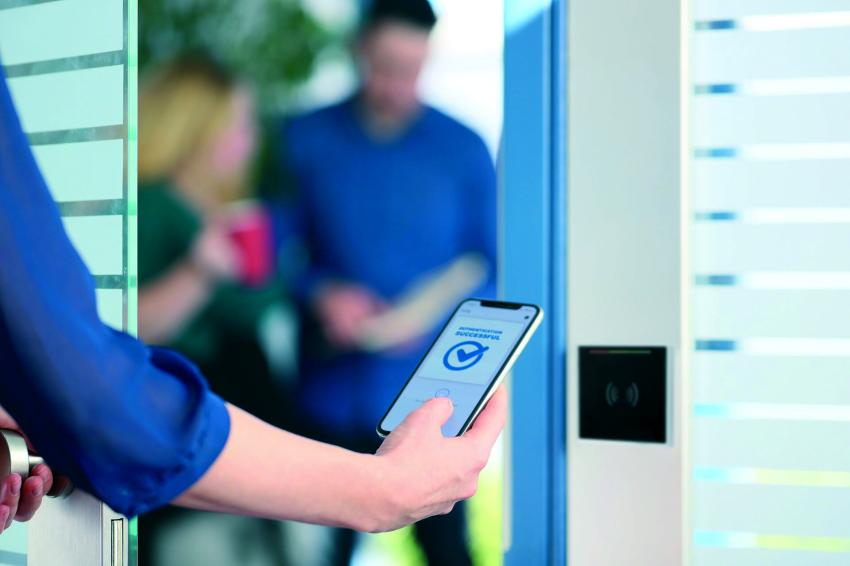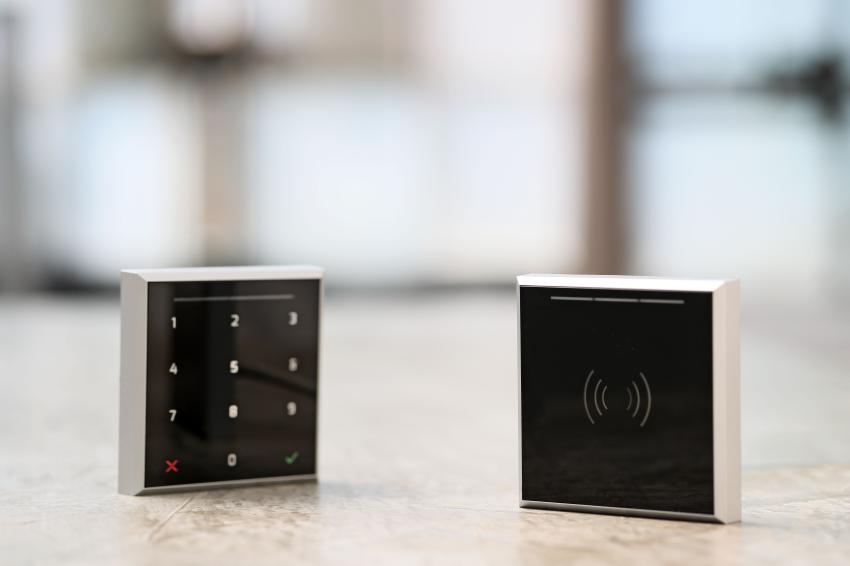Hybrid Access Control System: Parallel Use of RFID Cards and Smartphones
06.12.2022 - Smartphones with mobile credentials should not replace classic ID cards with RFID for access control altogether.
Increasingly, Smartphones are replacing the classic ID card in access control, although it is not possible or practical to replace cards based on RFID (Radio Frequency Identification) by mobile credentials everywhere. To provide maximum flexibility, a modern solution should therefore support both RFID and mobile technology. At the heart of this are versatile readers.
Smartphones and Wearables Increasingly Popular in Access Control
Contactless applications based on RFID have established themselves in access applications to create security for assets and for people. For a long time, RFID transponder cards were considered the identification medium of choice when it came to granting access to defined areas just to people with the appropriate authorization. But a change is emerging here: digital credentials, so-called mobile credentials, on smartphones or in the form of wearables are becoming increasingly popular in access control.
For the users, this eliminates the need to carry an additional physical credential which, unlike the ever-present smartphone, can be more easily forgotten or lost.
Advantages of Digital Badges for Access Control System Operators
- No keys or cards need to be handed out.
- it can be easily blocked via Smartphone in the event of loss or theft and replaced later.
- It is quick and easy to issue authorization for different user groups, such as visitors, customers, service providers, or guests.
- These authorizations can be limited as required to the premises and to the times during which they may be entered.
BLE or NFC: Two Standards for Mobile Access Control
Standard Bluetooth App
Two different transmission standards can be used for mobile access control. Users usually need an app on their cell phone for the BLE (Bluetooth Low Energy) standard – for example, a hotel app replaces the room key. BLE can also be used wherever a longer reader range is required, such as when opening parking garage barriers.
Mobile Passport in Encrypting Wallet
Unlike BLE, NFC (Near Field Communication) does not always require a manufacturer-specific app. Instead, the access authorization can also be stored as a mobile passport directly in the smartphone’s encrypting wallet where a Mifare DESFire card is emulated. This results in a reading distance of a few centimeters, as is common for such cards. Such a solution is therefore ideal wherever classic access applications are used. NFC is also particularly suitable for temporary access authorization, such as for visitor badges.
| BLE | NFC |
|---|---|
| Long range reader | Distance of a few Centimeters |
| Users need app | Mobile Passport in encrypting wallet of smartphone |
| e.g. hotel app replaces room key | e.g. classic access applications, suitable for temporary access authorization |
Hybrid Systems: Parallel use of RFID cards and smartphones is useful for heterogenous groups
Even though the trend towards smartphones is clearly visible, the access card is still used, especially since many companies also use the card as an employee ID. If companies or institutions want to be flexible in their access control and be able to use both options, a solution is needed that supports both analog and digital credentials.
The parallel use of RFID cards and smartphones is particularly useful wherever access is to be granted to heterogeneous user groups. One example would be the campus of a university where employees, such as lecturers, can be granted access with a card while students, visitors, or service providers use their smartphone for authentication. Whether for events, in hotels, or on cruise ships – a hybrid solution is the best option in all industries where an access control system must conveniently provide security and function for different groups of users.
At the heart of such a hybrid solution are access control readers that work with both smartphones and cards. But in addition to mobile technology, versatile readers should also be able to process a wide variety of transponder technologies. After all, not all RFID cards are the same. Companies or organizations with several – possibly even international – branches often use different transponder technologies at each location to regulate access to the building; this is very often the case when systems have grown over a long period of time. So to nevertheless be able to provide simple and cost-effective access for different user groups, such as employees, visitors, or service providers, a versatile solution is required that can be adapted to the needs of a company and its facilities. Multifrequency readers are available on the market that support up to 60 other transponder types in addition to BLE and NFC, and are certified for use in up to 110 countries worldwide. Such a broad spectrum ensures that the operators of access control systems are prepared for any new requirements that may arise, for example as a result of new technology or newly added user groups.
Do companies have to migrate the old or install a new hybrid access control system?
Companies or organizations that want to future-proof their access control system and enable the use of mobile technology do not necessarily have to install a completely new system – it is also possible to migrate an existing reader system. This is because existing readers can be replaced by new, versatile readers to meet both current and future requirements. The wiring and other components of the system can usually be retained. Solution providers in access control and intrusion detection technology, such as Sesamsec, can support building operators during the migration and show them their options for the changeover.
In addition to the classic card, the smartphone is becoming increasingly important as an identification medium in access control. Which of the options is used depends largely on the needs of the users and operators. A hybrid system that works with both smartphones and cards, therefore, makes sense, particularly when an access control system is used by different groups of people. This calls for versatile readers that support NFC and BLE in addition to various RFID transponder technologies and thereby provides a solution for all user groups. In this way, not only can newly installed access control systems be future-proofed, but existing ones can also be modernized.











